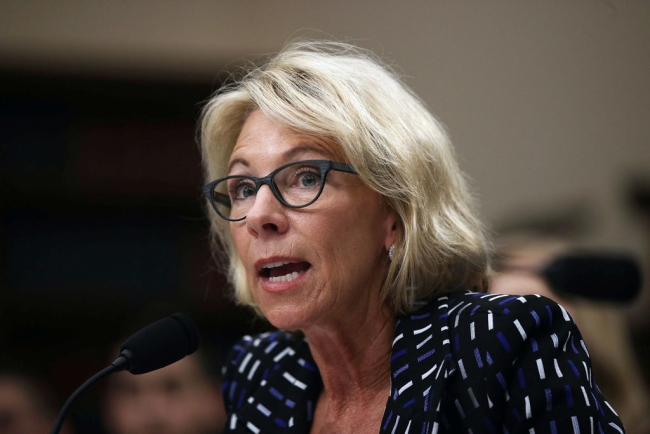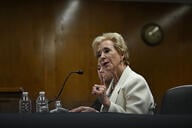You have /5 articles left.
Sign up for a free account or log in.

Education Secretary Betsy DeVos testifying to House appropriators.
Getty Images
Education Department officials today announced a plan to grant partial debt relief to defrauded student borrowers based on the earnings of graduates who attended a particular program of study.
It’s a significant departure for the department, which under the Obama administration had granted full relief to borrowers, such as the thousands of former Corinthian Colleges students who sought to discharge their student loans after the collapse of the for-profit chain in 2015. It’s also the first clear indication of how the Trump administration and Betsy DeVos, the education secretary, who had criticized the department's approach under Obama, plan to handle debt-relief claims.
Department officials said the new policy will specifically address findings for former Corinthian students. The same analysis for partial relief will be used for borrowers who attended other programs going forward, depending on the number of claims from a given institution.
Borrower defense to repayment, until recently a little-used provision of the Higher Education Act, allows borrowers to seek forgiveness of federal student loan debt when they are defrauded or misled by their institution. The Obama administration granted thousands of those claims and, in its final months, made an aggressive push for applications from more eligible borrowers who attended failed for-profit programs such as the ones Corinthian operated.
But since the transition in January, new reviews of those claims slowed to a complete halt while the new administration reassessed existing policies for adjudication of claims. More than 100,000 claims are currently pending at the department -- a number officials say will drop with the release of new rulings to individual borrowers.
The department will issue about 12,900 approved claims with a wave of letters to borrowers in coming weeks, officials said, including some notices of partial relief. Another 8,600 denials will be sent to applicants at the same time. The letters would be the first notice from the department to borrowers in close to a year.
“We have been working to get this right for students since day one,” DeVos said in a written statement. “No fraud is acceptable, and students deserve relief if the school they attended acted dishonestly. This improved process will allow claims to be adjudicated quickly and harmed students to be treated fairly. It also protects taxpayers from being forced to shoulder massive costs that may be unjustified.”
Department officials held internal discussions for months prior to today’s announcement about whether and how to grant partial relief to borrowers with pending debt-relief claims. Officials argued today that the adjudication of those claims should acknowledge the value a program provided. To reach a determination that 100 percent of a federal loan should be forgiven, they said, the department would have to overlook any value a borrower got from their program.
They also argued that both the existing Clinton-era statutory language laying out the borrower-defense process as well as more expansive regulation the Obama administration finalized last year (since delayed by DeVos) allowed for partial relief of claims when appropriate.
The new formula for partial relief announced today will grant discharge amounts based on the typical earnings of a graduate who attended a specific program compared to the typical earnings for graduates who attended comparable postsecondary programs using gainful employment data collected by the department. The department would use median or average earnings to make that determination -- whichever is more generous to the individual applicant.
Borrowers who attended a program where earnings were 49 percent or less than those of graduates from a comparable program would receive full discharge. Above that, partial relief would be granted on a sliding scale.
![CCI [Corinthian Colleges] Earnings as a Percentage of Gainful-Employment Earnings: 1 percent to 49 percent—100 percent relief. 50 percent to 59 percent—50 percent relief. 60 percent to 69 percent—40 percent relief. 70 percent to 79 percent—30 percent relief. 80 percent to 89 percent—20 percent relief. 90 percent and above—10 percent relief.](/sites/default/server_files/media/partial-relief-formula_0.png)
The department said it would not make a partial relief finding based on individual borrowers' earnings because it does not have that data for applicants.
The basis for ruling whether any discharge is appropriate, however, will remain the same -- such as for misleading claims involving job placement rates, job guarantees or transfer of student credit. For the 12,900 approved claims announced Wednesday, the department already has ruled that some form of relief is warranted. But in many cases, its staff are still determining how much loan forgiveness should be granted.
Department officials acknowledged that one rationale for the switch to consideration of partial relief is the cost to taxpayers of the borrower-defense program. But they said the department did not have projections of the potential savings of using that standard versus an “all-or-nothing” approach. They also leaned heavily on a recent department inspector general report in justifying the move, saying it showed clear weaknesses in reviewing and processing relief claims.
Student advocates were quick to criticize the shift in policy. Debbie Cochrane, vice president of the Institute for College Access and Success, said if DeVos's goal was improve upon what she called a "muddled process" for student relief, the department's announcement shows they are moving in the wrong direction.
"It will make the process even more muddled for borrowers and the government," Cochrane said in an email. "The new draconian limits on student loan discharges would punish borrowers who manage to stay afloat despite being mistreated by their schools. A student lured into enrolling in and borrowing for a worthless program might see minimal to no relief if they were paying their bills by working in a completely unrelated job, earning minimum wage.”
Other advocates said the formula for debt relief ignored whether a borrower was actually able to find a job in their field of study and that it would compare graduates to dropouts.
Clare McCann, the deputy director of higher education policy at New America and a former Obama Education Department official, said the announcement leaves unanswered a lot of questions about how exactly the formula for partial relief will work. She also questioned whether it is fair and legal to apply a different relief formula for Corinthian borrowers depending on the date their claim is reviewed.
“There are also questions about whether or not this is really an appropriate way to develop this partial relief framework, given that there’s an ongoing rule-making process where they can get insight from stakeholders,” she said.
McCann also pushed back on the department’s use of the recent inspector general report, which found no issues with rulings on claims that had already gone out the door.
“This appears to have been an unnecessary delay to come up with a process that’s confusing to borrowers and leaves everyone not knowing where they stand right now,” she said.
Last month, 26 Congressional Democrats sent a letter to DeVos and A. Wayne Johnson, chief operating officer of the Office of Federal Student Aid, warning that the gainful employment data were never intended to be used as the basis for determining student loan relief. They said the department could not unilaterally decide to use the data for those purposes without going through a formal notice and comment process and making a report to Congress.
"This information was never intended to harm borrowers or limit assistance to them. Instead, the gainful employment data are intended to protect students from programs that leave them with debt they cannot repay," the Democrats wrote.
And they said the type of data collected was not intended for purposes of assessing relief claims. Earnings data are produced only for federal aid recipients who graduated their programs, while many borrower defense applicants may have dropped out or never finished -- that's especially true of those who attended for-profit programs that collapsed suddenly.




